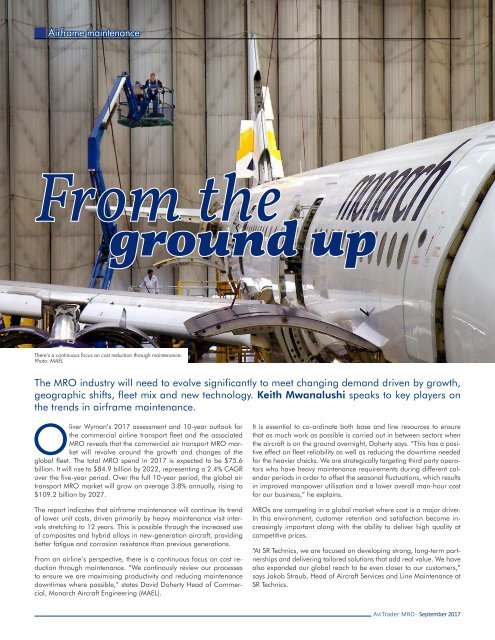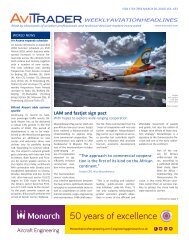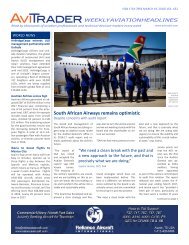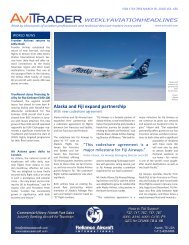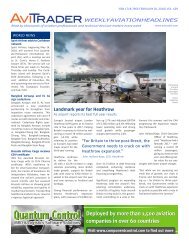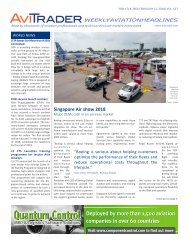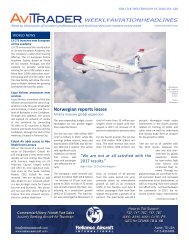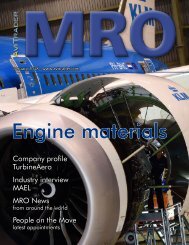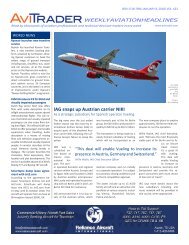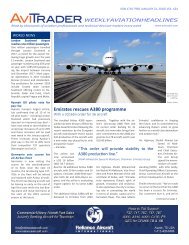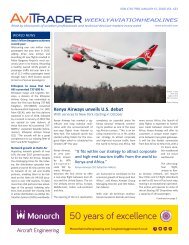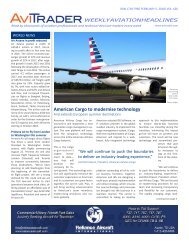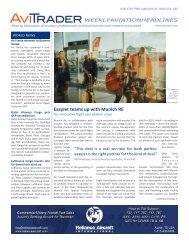AviTrader MRO Magazine 2017-09
AviTrader MRO Magazine 2017-09
AviTrader MRO Magazine 2017-09
You also want an ePaper? Increase the reach of your titles
YUMPU automatically turns print PDFs into web optimized ePapers that Google loves.
Airframe maintenance<br />
17<br />
From the<br />
ground up<br />
There’s a continuous focus on cost reduction through maintenance.<br />
Photo: MAEL<br />
The <strong>MRO</strong> industry will need to evolve significantly to meet changing demand driven by growth,<br />
geographic shifts, fleet mix and new technology. Keith Mwanalushi speaks to key players on<br />
the trends in airframe maintenance.<br />
O<br />
liver Wyman’s <strong>2017</strong> assessment and 10-year outlook for<br />
the commercial airline transport fleet and the associated<br />
<strong>MRO</strong> reveals that the commercial air transport <strong>MRO</strong> market<br />
will revolve around the growth and changes of the<br />
global fleet. The total <strong>MRO</strong> spend in <strong>2017</strong> is expected to be $75.6<br />
billion. It will rise to $84.9 billion by 2022, representing a 2.4% CAGR<br />
over the five-year period. Over the full 10-year period, the global air<br />
transport <strong>MRO</strong> market will grow on average 3.8% annually, rising to<br />
$1<strong>09</strong>.2 billion by 2027.<br />
It is essential to co-ordinate both base and line resources to ensure<br />
that as much work as possible is carried out in between sectors when<br />
the aircraft is on the ground overnight, Doherty says. “This has a positive<br />
effect on fleet reliability as well as reducing the downtime needed<br />
for the heavier checks. We are strategically targeting third party operators<br />
who have heavy maintenance requirements during different calendar<br />
periods in order to offset the seasonal fluctuations, which results<br />
in improved manpower utilisation and a lower overall man-hour cost<br />
for our business,” he explains.<br />
The report indicates that airframe maintenance will continue its trend<br />
of lower unit costs, driven primarily by heavy maintenance visit intervals<br />
stretching to 12 years. This is possible through the increased use<br />
of composites and hybrid alloys in new-generation aircraft, providing<br />
better fatigue and corrosion resistance than previous generations.<br />
From an airline’s perspective, there is a continuous focus on cost reduction<br />
through maintenance. “We continously review our processes<br />
to ensure we are maximising productivity and reducing maintenance<br />
downtimes where possible,” states David Doherty Head of Commercial,<br />
Monarch Aircraft Engineering (MAEL).<br />
<strong>MRO</strong>s are competing in a global market where cost is a major driver.<br />
In this environment, customer retention and satisfaction become increasingly<br />
important along with the ability to deliver high quality at<br />
competitive prices.<br />
“At SR Technics, we are focused on developing strong, long-term partnerships<br />
and delivering tailored solutions that add real value. We have<br />
also expanded our global reach to be even closer to our customers,”<br />
says Jakob Straub, Head of Aircraft Services and Line Maintenance at<br />
SR Technics.<br />
<strong>AviTrader</strong> <strong>MRO</strong> - September <strong>2017</strong>


